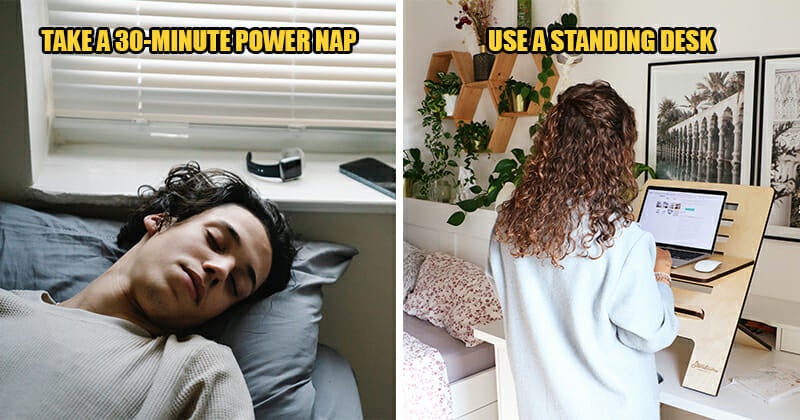Aching to reach for a pick-me-up coffee after lunch? You’re not alone! Due to our body’s natural circadian rhythm, we tend to feel sleepy and less alert between 1pm and 4pm. This common phenomenon is known as the afternoon slump.
While the circadian rhythm is mainly responsible for fatigue, many other factors can contribute to the energy slump, such as:
- Sleep deprivation
- Dehydration
- Poor diet
- Excessive stress
Before you reach for another cup of coffee, let us assure you that there are science-approved ways to fight midday fatigue effectively. Keep on reading to find out how!
1. Have nutrient-dense foods for lunch
Having high-calorie meals that consist of fried foods, saturated animal fats, and simple carbohydrates can worsen the afternoon dip. This is because heavy meals trigger an insulin spike in our bodies, increasing the production of melatonin, a hormone that causes drowsiness.
Hence, to prevent daytime sleepiness, it is best to opt for fibre-rich fruits, leafy greens, and complex carbohydrates like whole grains, beans, and legumes. Need to munch on some snacks? Look for nutrient-packed foods like nuts, low-fat yoghurt, and berries instead of sugary energy bars!

2. Take a 30-minute power nap
Studies have shown that taking a 10 to 30-minute power nap enhances memory, improves cognitive functions, and promotes alertness. To overcome sleepiness during midday fatigue, it is advisable to take a nap before or during the post-lunch slump.
Be sure to nap in a dark, quiet, and cosy place, as light sources, noises, and uncomfortable temperatures can deteriorate your sleep quality. However, be careful not to oversleep, as it might leave you feeling groggy and worsen the afternoon dip.

3. Stretch and walk in the sunshine
If you can’t find an ideal napping place, try stepping into the sunshine! Exposure to natural light can help fight midday fatigue by increasing the production of serotonin in our brains. This hormone is known to boost our mood, improve calmness, and increase wakefulness.
While you’re soaking up the sun, remember to do some stretching or walk around your office! Light exercises can improve your blood circulation and increase the oxygen supply to the brain, giving you that much-needed energy boost.

4. Stimulate your senses to stay focused
Falling behind on work? Stay focused and productive during the afternoon slump by engaging your senses! There are a few easy methods you can try to boost productivity at work, such as:
- Chewing gum: improves oxygen flow to the brain
- Listening to classical music: engages both the left and right brain to maximise learning and improve memory
- Using focus-enhancing essential oils: stimulates areas of the brain that regulate emotion and motivation
- Rosemary
- Peppermint
- Sweet orange
- Spearmint

5. Stay hydrated
To fight sluggishness, you might be tempted to gulp down another cup of coffee or energy drink, but doing so does more harm than good! Excessive caffeine intake reduces your sleep quality at night, while sweetened energy drinks can result in sugar crashes that intensify your midday fatigue.
The best drink you can get during the 3pm slump is a good ol’ glass of water, which maximises physical performance, boosts energy, and improves brain functions. Besides, staying hydrated possesses various health benefits, such as promoting weight loss, boosting metabolism, and preventing headaches!

6. Use a standing desk or work in groups
Long hours of sitting and screen time can easily drain your energy, leaving the afternoon slump more unbearable. Instead of lounging on your seat, try using a standing desk! Standing while working does not only burn calories, but it can also improve your posture and boost blood circulation, allowing you to concentrate easier.
Alternatively, you can arrange meetings, discussions, and group work sessions during the post-lunch slump to combat sleepiness. This is because socialising triggers the production of oxytocin, a happy hormone that inspires creativity and boosts concentration.

While the symptoms of the 3pm slump can be alleviated, the afternoon dip caused by the body’s circadian rhythm is often inevitable.
Nonetheless, you can still tailor your workload to your energy levels by tackling challenging tasks in the morning and attending to easier tasks after lunch hour. This way, you get to minimise the impact of the afternoon slump on your work performance.
Are you struggling with the dreaded afternoon slump? What do you usually do to fight fatigue and stay productive? Let us know in the comments below!
Also read: 5 Must-Have Items to Place On Your Office Desk For A More Productive & Contented Work Life





































